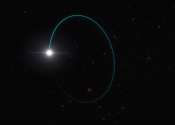Black hole 'traffic jams' discovered in galactic centers by astronomers
An international study, led by researchers from Monash University, has revealed crucial insights into black hole dynamics within massive disks at the centers of galaxies.

An international study, led by researchers from Monash University, has revealed crucial insights into black hole dynamics within massive disks at the centers of galaxies.
Astronomy
4 hours ago
0
12

In celebration of the 34th anniversary of the launch of NASA's legendary Hubble Space Telescope on April 24, astronomers took a snapshot of the Little Dumbbell Nebula (also known as Messier 76, M76, or NGC 650/651) located ...
Astronomy
23 hours ago
0
9

New research published in Nature showcases new observations from the James Webb Space Telescope (JWST) that suggest black holes rapidly shut off star-formation in massive galaxies by explosively removing large amounts of ...
Astronomy
Apr 23, 2024
0
241

South Africa's Karoo region is a vast semi-arid area that stretches across four of the country's provinces. It is sparsely populated and renowned for its wide open spaces.
Astronomy
Apr 23, 2024
0
51

Scientists believe the environment immediately surrounding a black hole is tumultuous, featuring hot magnetized gas that spirals in a disk at tremendous speeds and temperatures. Astronomical observations show that within ...
Astronomy
Apr 22, 2024
0
155

Astronomers identified the largest stellar black hole yet discovered in the Milky Way, with a mass 33 times that of the Sun, according to a study published on Tuesday.
Astronomy
Apr 20, 2024
2
109

A research team from the University of Science and Technology of China (USTC) of the Chinese Academy of Sciences (CAS) presented a detailed analysis of a tidal disruption event (TDE) with unique characteristics, providing ...
Astronomy
Apr 17, 2024
0
14

Astronomers have identified the most massive stellar black hole yet discovered in the Milky Way galaxy. This black hole was spotted in data from the European Space Agency's Gaia mission because it imposes an odd 'wobbling' ...
Astronomy
Apr 16, 2024
1
868

When faraway stars explode, they send out flashes of energy called gamma-ray bursts that are bright enough that telescopes back on Earth can detect them. Studying these pulses, which can also come from mergers of some exotic ...
Astronomy
Apr 16, 2024
0
2

One of the big mysteries about dark matter particles is whether they interact with each other. We still don't know the exact nature of what dark matter is. Some models argue that dark matter only interacts gravitationally, ...
Astronomy
Apr 15, 2024
3
10
In general relativity, a black hole is a region of space in which the gravitational field is so powerful that nothing, including light, can escape its pull. The black hole has a one-way surface, called an event horizon, into which objects can fall, but out of which nothing can come. It is called "black" because it absorbs all the light that hits it, reflecting nothing, just like a perfect blackbody in thermodynamics. Quantum analysis of black holes shows them to possess a temperature and Hawking radiation.
Despite its invisible interior, a black hole can reveal its presence through interaction with other matter. A black hole can be inferred by tracking the movement of a group of stars that orbit a region in space which looks empty. Alternatively, one can see gas falling into a relatively small black hole, from a companion star. This gas spirals inward, heating up to very high temperature and emitting large amounts of radiation that can be detected from earthbound and earth-orbiting telescopes. Such observations have resulted in the scientific consensus that, barring a breakdown in our understanding of nature, black holes do exist in our universe.
This text uses material from Wikipedia, licensed under CC BY-SA